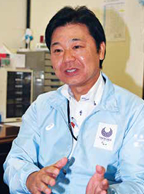
Reconstruction is under consideration due to deterioration, but Tetsuji Nagao, Chairman of the New Shimbashi Building Shop Association, says, "I want to preserve the spirited environment that embodies Shimbashi."
Shortly after the Second World War, the location where the New Shimbashi Building stands was a newly formed market among the largest in Japan, packed with shops. Afterward, the New Shimbashi Building debuted in 1971 by way of an urban restructuring project. At the time it was built, compound buildings in which commercial establishments gathered in one place were rare on a national scale. In addition, the louver-shaped screen covering the second and third floors, designed by MHS Planners, Architects & Engineers Ltd., also gained attention for its novel design. There is a shopping district from the basement to the fourth floor, and there are offices from the fifth to the ninth floor and residential spaces on the tenth and eleventh floors. Even now, around 300 shops populate the shopping district, which bustles with working men and women when lunchtime rolls around. Just after the building was completed, most of the shops were cafes and clothing stores. While such shops have decreased in number, even now there are cafes that allow you to feel the spirit of the Showa period, such as Coffee Fuji, Cattleya, and Coffee Room Powa, and many customers visit these establishments each day.
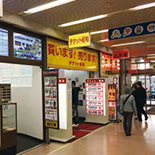
Many businessmen who use bullet trains and airplanes for business trips visit the ticket shops.
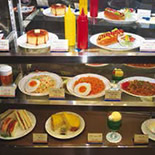
Cafes wafting with the spirit of the Showa period are also indispensable to the New Shimbashi Building.
In terms of another well-known feature of the New Shimbashi Building, you can't overlook the large number of ticket shops. Originally, Shimbashi had many antique shops, which sold old stamps and the like, and pawnshops. Over the years, such shops have been reborn as ticket shops, of which there are currently almost 20 in the building. Given the large number of shops, they also carry many types of tickets. These shops have earned the trust that if customers visit them, they can procure their desired tickets.
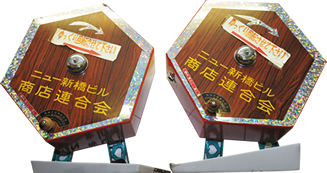
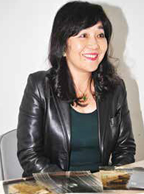
"The building is charming for its friendly nature," says Keiko Kawata, Chairperson of the Shimbashi Ekimae Building Management Association Corporation.
The Shimbashi Ekimae Building was originally a bar district called "Tanuki (raccoon dog) Alley." An urban restructuring project to create this building was carried out following the 1964 Tokyo Olympics, and construction was completed in 1966. There are shops from the basement to the second floor, and offices from the third to the ninth floor.
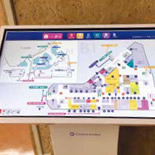
This is a touch panel for guidance. It allows visitors to look up the locations of the shops on each floor and the paths to take in order to change trains.
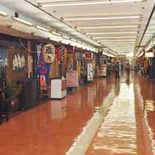
Cafes wafting with the spirit of the Showa period are also indispensable to the New Shimbashi Building.
The restaurant area contains many shops that had been in Tanuki Alley, unchanged from the past. Even now, the atmosphere from that time remains. Tanuki Alley was reproduced in order to fulfill the requests of the restaurants, which had expressed that they wanted the back alley bar feel to be preserved in the building. In addition, borrowing from the Tanuki Alley name, the entrance on the first floor is adorned with a statue of a tanuki. This was not present at the time of the building's construction; it was built later by volunteers. At first there was a box for donations, but for crime prevention reasons, it has been removed. Due in part to the fact that the Shimbashi Ekimae Building is connected to a transportation network, many people enter it by mistake upon losing their way when changing trains. Further, owing to factors such as an increase in foreign tourists, touch panels for guidance have been installed.
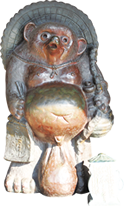 There is a bronze statue of a tanuki near the building's first floor entrance. This is unique to the Shimbashi Ekimae Building.
While there is a chance of redevelopment after the 2020 Tokyo Olympic and Paralympic Games , Keiko Kawata, Chairperson of the Shimbashi Ekimae Building Management Association Corporation, says “I would like to keep the current ambiance of the building that helps you to relax.” As the number of new shops grows with the changing times, there also exists traditional shops which have been coming along with the history of the building. The Shimbashi Ekimae Building remains unchanged from 50 years ago, still providing comfort to many people.
There is a bronze statue of a tanuki near the building's first floor entrance. This is unique to the Shimbashi Ekimae Building.
While there is a chance of redevelopment after the 2020 Tokyo Olympic and Paralympic Games , Keiko Kawata, Chairperson of the Shimbashi Ekimae Building Management Association Corporation, says “I would like to keep the current ambiance of the building that helps you to relax.” As the number of new shops grows with the changing times, there also exists traditional shops which have been coming along with the history of the building. The Shimbashi Ekimae Building remains unchanged from 50 years ago, still providing comfort to many people.
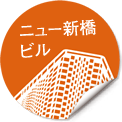
This shop rejuvenates businessmen with highly nutritious juice.
Fruit Ozawa
Fruit Ozawa provides hardworking Shimbashi workers with rejuvenating beverages. It was originally a fruit shop, and has assumed the style of a juice stand since around the year 2000. The storefront is lined with lots of brightly colored fruits, and there are normally over 30 varieties available on the juice menu. Seasonal offerings also appear, featuring flavors such as strawberry in the spring and watermelon in the summer. While sales do differ depending upon the season, the shop sells from 200 to 300 cups of juice each day.
The secret to the shop's popularity is the high nutritional value of the juice. This is possible because the shop serves cold-pressed juice, in which the juice is made in a slowly rotating juicer that does not apply heat, and the ingredients are crushed using high pressure. Normal juicers mince the ingredients with high-speed rotation, destroying oxygen in the process and leading to the loss of nutrition. We have been told that with Fruit Ozawa's method, on the other hand, the oxygen is unharmed, resulting in juice with roughly four times the nutritional value of products made with normal juicers.
The shop also has a wide selection of vegetables such as Japanese radish, celery, Japanese mustard spinach, and broccoli, and customers can choose menu items in accordance with their desired benefits, such as recovery from exhaustion; cures for hangovers, cold sensitivity, and constipation; and so forth. Since the juices also use plenty of apple and lemon, they taste great and are easy to drink.
"I think many people are exhausted from work or have unbalanced nutrition, so I want to provide something healthy," says shop owner Kazushige Arai.
While valuing the basic concept of healthy products, the shop is also devoted to developing new menu items. Currently, the shop is looking into a menu item that uses beets, which are known as a miracle vegetable. Fruit Ozawa continues to revitalize the people who work in Shimbashi with cups of juice.
SHOP DATA
| Address: | 1F New Shimbashi Building, 2-16-1 Shimbashi, Minato-ku, Tokyo |
| Phone: | 03-3501-3704 |
| Hours: | 8:00 AM to 8:00 PM (Monday to Friday), 9:00 AM to 6:00 PM (Saturday) |
| Closed: | Sundays, national holidays |
| Access: | A 1-minute walk from Shimbashi Station on JR |
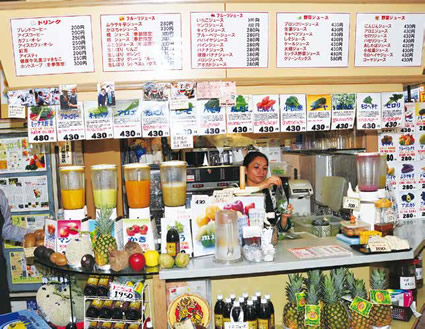
The shop offers many varieties of juice, including seasonal selections.
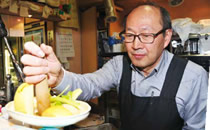
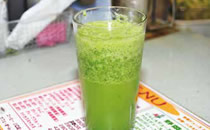
At this shop, you can savor highly nutritious, cold-pressed juice. It has no grassiness at all, tastes great, and is easy to drink.
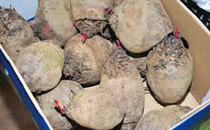
The shop is also devoted to developing new juices. We hear they are currently investigating a juice that uses beets.
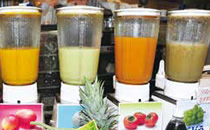
The fruit juices with seasonal fruits are recommended. Popular choices include strawberry in the spring and watermelon in the summer.
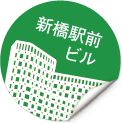
A comfortable restaurant where customers can relax with attentive service.
Makinoya
Map >> 16
Makinoya is a restaurant that first-time customers will want to visit again--so much, in fact, that we hear 90% of the customers are repeat visitors. Due partially to the fact that the husband of the hostess was famed judo practitioner Kaneo Iwatsuri, many celebrities visit the restaurant. However, the staff tend to customers with the stance that the moment you pass through the curtain at the entrance, you are a valued customer regardless of social status. Not even presidents of large companies or immensely famous celebrities are given special treatment. With businessmen making up much of the customer base, the staff endeavor to provide a space where customers can forget about their jobs. This kind of customer service has created a comfortable atmosphere where everyone in the shop feels like family.
One especially popular menu item is a stir fry with beef and konnyaku (devil's tongue) noodles. The recommendation is to make this a set with an exquisite egg from Fukaya in Saitama Prefecture, which costs 200 yen (for one), and eat it sukiyaki-style. The exquisite eggs have such rich flavor that you can grab the yolks with your chopsticks. If some of the egg is left over, you can receive complimentary rice and pour the egg over it to have two delicious experiences in one.
The potstickers, which are similarly popular, are not a standard menu item, but something limited to reservations. Since the restaurant is particular about the wrappers and ground meat, the staff only procure the ingredients from a specific shop when they have received a reservation. The potstickers were originally an item made for the staff using leftover ingredients, but they were added to the menu when customers who saw them expressed that they wanted to eat some.
The restaurant is only open on weekdays. It does not operate on weekends or national holidays, since the customer base in Shimbashi changes during those times. Makinoya continues to provide soothing service as a shop thoroughly for businessmen
SHOP DATA
| Address: | B1F Shimbashi Ekimae Building No. 2, 2-21-1 Shimbashi, Minato-ku, Tokyo |
| Phone: | 03-3571-1695 |
| Hours: | 5:00 PM to 11:00 PM (Monday to Friday) |
| Closed: | Saturdays, Sundays, and national holidays |
| Access: | A 1-minute walk from Shimbashi Station on JR, the Tokyo Metro Ginza Line, and the Toei Asakusa Line |
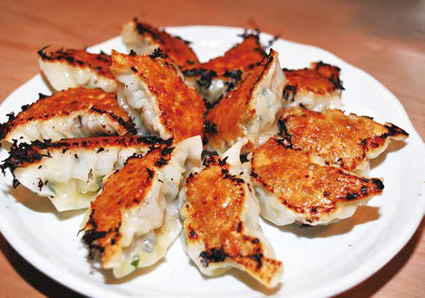
The potstickers, a popular menu item, were originally made for the staff members using leftover vegetables. You need a prior reservation to order them.
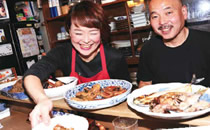
Consistent with the phrase "customer service must always produce satisfaction," the restaurant is full of a comfortable brightness.
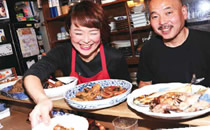
Due partially to the fact that the husband of the hostess was famed judo practitioner Kaneo Iwatsuri, the shop's interior is full of signatures from celebrities such as Olympic athletes.
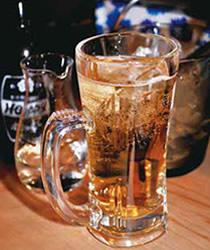
Shochu (a clear liquor distilled from sweet potatoes or barley) and Hoppy come separately, and customers can adjust their drinks to their preferred strength.
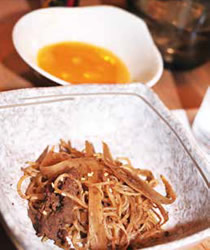
Eat the beef and konnyaku noodle stir fry as a set with an exquisite egg, priced at 200 yen (for one). If some of the egg is left over, you can receive rice and pour the egg over it.











